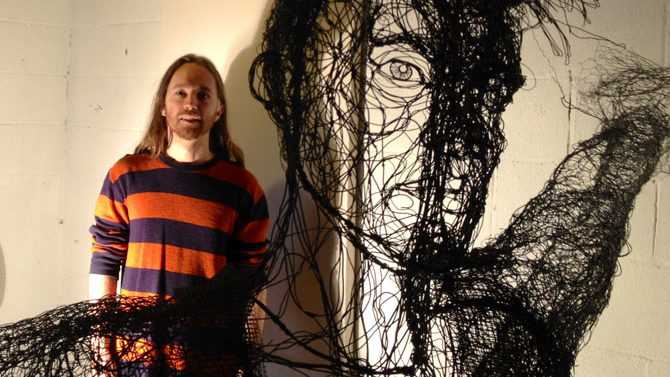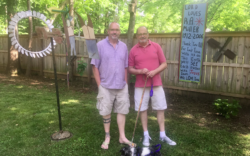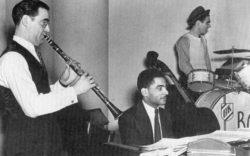Noah Saunders confesses that he “really moved to Athens for the cheaper rent.” The sculptor, who works primarily with fencing wire, laughs about how little he knew about the town before locating here when he was 20 years old. Apparently, things worked out; 15 years later, he happily calls Athens home.
“People come to Athens to do something beyond ‘career,’” Saunders says. “They come to learn, to study. It’s easy to manifest dreams here.”
One of Noah’s dreams has come to fruition, with a 25-year retrospective of his signature three-dimensional wire portraits currently on display at the HoFP Gallery in Columbia, SC. The show includes some works on loan that had been previously purchased at the artist’s first exhibit at the gallery, which took place when Saunders was only 16.
“In fifth grade, this guy showed us how to make little people out of pipe cleaners. But he only gave us five pipe cleaners, and I was incensed, because I wanted more,” says Saunders. That marked the beginning of the artist’s lifelong obsession with wire. Saunders went home that day to scour the house for pipe cleaners and wire. He even resorted to tearing out the spiral edging on his notebooks—anything he could find to complete the figure he had started in school.

Photo Credit: Noah Saunders
That visiting artist also introduced Saunders to the work of Alexander Calder, including his “Circus.” Calder proved to be a lifelong inspiration. “Calder did wire portraits in the 1920s. He dropped the idea at a point,” Saunders says, “but I feel like I picked it up to push it to its furthest limits.”
Saunders found his subject of choice that day, as well as his favorite medium. In fact, his interest in portraiture and the human figure influenced his decision to leave Georgia State University after only one semester. (“Figure studies weren’t popular with sculptors at that time,” he says.) Saunders left art school and devoted himself to making art full-time, a choice his parents supported.
Saunders keeps his tools to a minimum, relying mostly on simple pliers. He suspends his works from the ceiling in his studio, and then projects photographs of his subjects onto the wall to help guide him in decision-making. A light shines on the work in progress, casting shadows integral to the process and, later, the viewing and experience of the works.
Saunders, who often deals with 100 different strands of wire in a single portrait, says “wire is, in essence, a line you can hold.” The finished pieces have the energy and beauty of dynamic drawings, while simultaneously being three-dimensional pieces meant to be viewed from every angle, along with their cast shadows. Most are meant to be hung in space, and the resulting motion and changing shadows become part of the complex works. The expressions in his portraits change as they move.

Photo Credit: Barbette Houser
The largest work the artist has ever created, “Amazing Grace,” is a portrait of a dancer from New York. Saunders created it as part of a series he is doing in partnership with UGA about how social media is changing the roles of artists. Saunders relied on 40 pictures from the dancer’s Facebook page to portray his grace and motion.
Saunders is now working on a portrait of Sterling Dorminey commissioned by his mother, Betsy. His patron says, “Noah’s sculpture is like a 3D line drawing in braille: a pencil traveling through space, leaving a trail of metal behind. Or topographical maps. To me, they look so lifelike that I almost expect them to breathe and speak.”
The thoughtful, long-haired, soft-spoken artist is frequently seen around town, usually with book in hand. It’s clear that he gives the art-making process a great deal of consideration, and he is a keen observer. Many of his pieces are inspired by the people that he sees at places like Big City Bread and The National.
Locally, Saunders shows his wire sculptures at Aurum Studios, and his jewelry is sold at Frontier. “Even if it doesn’t have a lot of galleries [or] other means of support for artists,” he says, “Athens is a great place to live and to be an artist in.”
Like what you just read? Support Flagpole by making a donation today. Every dollar you give helps fund our ongoing mission to provide Athens with quality, independent journalism.










